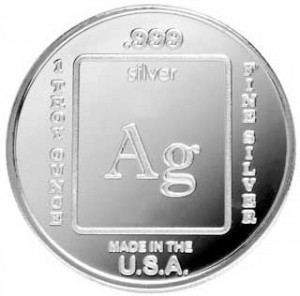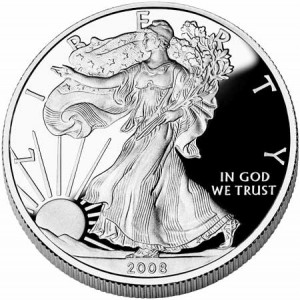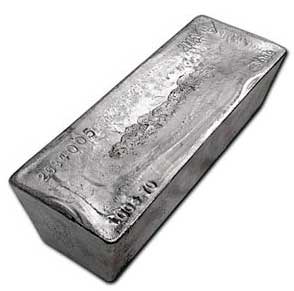|
|
Silver Bars and Rounds
 |
100 Ounce Silver Bars These are very popular with people who want to buy a lot of silver. The buy-sell spread difference is very small, and the size is very compact. A #10 safe deposit box will hold more bars than a person can lift. Buyers should purchase widely known, accepted brands such as Engelhard, Johnson Mathey, Sunshine Mining, etc. Odd brands and older bars that are not exactly 100 troy ounces will be discounted when they are sold to dealers. 1000 ounce bars are a bit cheaper than 100 ounce bars, but due to the massive size and weight (about 70 pounds) they are not recommended. |
 |
Generic One Once Silver Rounds or Bars The coin-like rounds are always .999 silver and weigh a troy ounce. Silver bars have been minted by various “private mints” and refiners since the middle 1960′s. Many ingots are from the 1965-75 era, and had some commemorative or special event theme and were called “art bars”. At one time these were collectable but all are now worth only their silver content. The one ounce bars and rounds are almost always accepted by dealers, and there have been extremely few problems about weights or fineness. These are especially popular because the premiums over silver are relatively small, a few percent over the spot silver price. These are a good buy, if the premium stays this low. We recommend these due to the low premium (Jan 2011: Eagles cost $4 over spot; rounds and bars just $1.25). Premiums vary as to market conditions.
|
 |
.999 Silver 1 Troy Ounce Coins These are issued by established governments and have some nominal value such as $1 for the US silver eagle; $5 for the Canadian silver Maple Leaf, etc. The nominal value is always a fraction of the silver value. It gives the coins legal tender status though no one would spend a coin for the face value when the silver content is many times that. These coins are more popular than silver rounds, and usually always initially cost more because the governments issuing them charge a higher minting fee. For example, the dozen or so distributors who buy the silver eagle coins directly from the US mint have to buy about a million dollars worth at a time, and have to pay the mint up front about $3 a coin over spot. Under normal circumstances the distributors sell these to coin and bullion dealers 500-1000 at a time for about $3 a coin over silver. During occasional mint stoppages, the distributors were selling the eagles way over the silver price due to the short supply and great demand.
Larger .999 Silver Rectangles and Bars
These are all made by refiners, mines and private mints, and commonly come in one, ten and 100 ounce size. All the one ounce size rectangles and newer bars are die struck. Most of the older 10 & 100 oz. bars were made from a casting process where the silver was poured into a mold and then the trademark and fineness and weight were later stamped. Modern bars are die struck or “extruded”, an Engelhard process where the metal is rolled (extruded) into thick sheets, trademark serial numbers and weights added in the same process. All 100 ounce bars have serial numbers. The larger size bars are popular because they are more compact, fit nicely into safe deposit boxes and easily hidden in homes.
|
 |
1000 Ounce COMEX Delivery Bars COMEX uses 1000 ounce .999 silver bars to satisfy delivery contracts. These are rather ugly, like a long skinny loaf of bread, crudely poured and the stamps are usually crude. Some are exactly 1000 troy ounces, but many are a little lighter or heavier. The total weight is around 70 regular pounds. They are difficult to move and expensive to ship. The commodity exchange makes it very expensive (shipping charges, excessive fees) to add or remove from the COMEX warehouse. These are seldom bought or sold from the general public. In our store we see just a few per year. They can be sold to coin and bullion dealers for spot less a few percent, and are sold to buyers for spot plus a few percent. |
|
|

